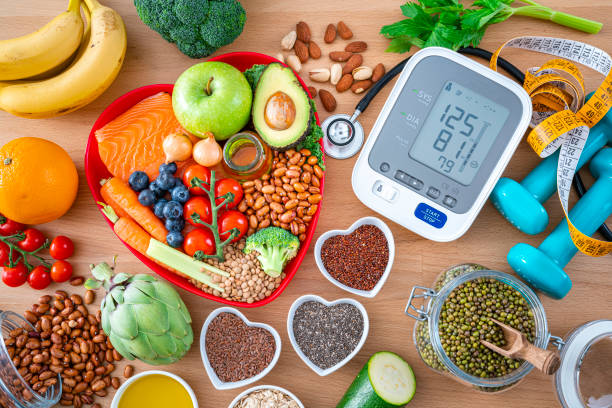A hypertension diet is a heart-healthy eating plan designed to help lower and manage high blood pressure. By focusing on nutrient-rich foods like fruits, vegetables, whole grains, lean proteins, and low-fat dairy, while reducing sodium, saturated fat, and processed foods, this diet supports better cardiovascular health. It’s a natural, effective approach to prevent complications like heart disease, stroke, and kidney problems.
What is a Hypertension Diet?
A hypertension diet is a nutritional approach designed to lower high blood pressure (hypertension) and improve heart health. High blood pressure, often called the “silent killer,” increases the risk of heart disease, stroke, kidney failure, and other serious health issues.
The most well-researched and widely recommended diet for managing hypertension is the DASH diet — Dietary Approaches to Stop Hypertension. This eating plan focuses on reducing sodium, increasing potassium, magnesium, and calcium, and promoting a balanced, heart-healthy lifestyle.
Why Diet Matters for Hypertension?
High blood pressure occurs when the force of blood against artery walls is consistently too high. This pressure damages arteries over time, leading to health complications. While genetics and lifestyle play a role, diet is a major modifiable factor in controlling blood pressure.
The right diet can:
- Lower systolic and diastolic blood pressure
- Reduce strain on the heart and arteries
- Support weight loss and cholesterol balance
- Improve blood sugar control
- Reduce the need for medications
Key Nutrients for Blood Pressure Control:
| Nutrient | Role | Sources |
|---|---|---|
| Potassium | Balances sodium and helps relax blood vessels | Bananas, spinach, potatoes, beans |
| Magnesium | Helps regulate blood pressure and heartbeat | Nuts, seeds, whole grains, leafy greens |
| Calcium | Essential for vascular contraction and dilation | Low-fat dairy, broccoli, fortified plant milks |
| Fiber | Lowers cholesterol and blood pressure | Fruits, vegetables, legumes, whole grains |
| Omega-3 Fatty Acids | Reduces inflammation and supports heart health | Fatty fish, flaxseeds, walnuts |
Foods to Eat on a Hypertension Diet:
These foods help lower blood pressure, reduce inflammation, and support heart health. Focus on whole, nutrient-dense, low-sodium options rich in potassium, calcium, magnesium, and fiber.
Fruits:
- Best choices: Berries (blueberries, strawberries), bananas, oranges, apples, pears, watermelon
- Why: High in potassium, fiber, and antioxidants that help lower blood pressure.
Vegetables:
- Best choices: Leafy greens (spinach, kale), beets, broccoli, carrots, sweet potatoes, bell peppers
- Why: Rich in nitrates, potassium, and magnesium — essential for blood pressure regulation.
Whole Grains:
- Best choices: Oats, brown rice, quinoa, whole wheat bread, barley
- Why: High in fiber and nutrients that help maintain a healthy weight and lower cholesterol.
Low-Fat or Fat-Free Dairy:
- Best choices: Skim milk, low-fat yogurt, low-sodium cheese
- Why: Provides calcium and protein with less saturated fat and sodium.
Lean Proteins:
- Best choices: Skinless poultry, fish (especially fatty fish like salmon, tuna), tofu, legumes (beans, lentils)
- Why: Supports heart health without added sodium or saturated fat.
Nuts, Seeds, and Legumes:
- Best choices: Almonds, walnuts, chia seeds, flaxseeds, lentils, chickpeas
- Why: Contain magnesium, healthy fats, and fiber, which are beneficial for blood pressure.
Healthy Fats:
- Best choices: Olive oil, avocado, flaxseed oil
- Why: Rich in monounsaturated and omega-3 fats, which help reduce inflammation and improve heart health.
Herbs and Spices (Instead of Salt):
- Best choices: Garlic, turmeric, ginger, basil, oregano, lemon juice
- Why: Add flavor without adding sodium.
Foods to Avoid or Limit on a Hypertension Diet:
These foods are high in sodium, saturated fat, trans fats, and added sugars, all of which contribute to high blood pressure and heart problems.
Salty and Processed Foods:
- Examples: Canned soups, packaged snacks (chips, crackers), instant noodles, salted nuts
- Why: Extremely high in sodium; even small servings can exceed daily limits.
Processed and Cured Meats:
- Examples: Bacon, ham, sausages, deli meats, hot dogs
- Why: High in sodium and preservatives; often contain unhealthy fats.
Fast Food and Takeout:
- Examples: Burgers, fries, pizza, fried chicken
- Why: Loaded with salt, trans fats, and refined carbs.
Pickled and Fermented Foods (with salt):
- Examples: Pickles, sauerkraut, soy sauce
- Why: Often preserved in salty brine, raising sodium intake quickly.
Full-Fat Dairy and Fatty Meats:
- Examples: Whole milk, cream, butter, fatty cuts of beef or pork
- Why: High in saturated fat, which can raise LDL cholesterol and blood pressure.
Canned and Ready-Made Meals:
- Examples: Frozen dinners, canned pasta, boxed rice, or seasoning mixes
- Why: They usually contain hidden sodium and preservatives.
Sugary Foods and Drinks:
- Examples: Soda, energy drinks, candies, pastries
- Why: Contribute to weight gain, insulin resistance, and higher blood pressure.
Alcohol (Limit or Avoid):
- Why: Excess alcohol increases blood pressure and weakens the heart over time.
- Guideline: Max 1 drink/day for women, 2 for men — or less if advised by your doctor.
Sample One-Day Hypertension-Friendly Meal Plan
| Meal | Example |
|---|---|
| Breakfast | Oatmeal topped with blueberries, banana slices, and flaxseed; green tea |
| Snack | Low-fat yogurt with chia seeds and a handful of almonds |
| Lunch | Grilled chicken salad with leafy greens, cucumbers, tomatoes, olive oil & lemon dressing; whole grain roll |
| Snack | Sliced apple with unsalted peanut butter |
| Dinner | Baked salmon, steamed broccoli, quinoa |
| Dessert | Fresh strawberries with a dollop of plain Greek yogurt |
Final Thoughts:
A hypertension diet is a powerful, natural way to control and lower blood pressure. By focusing on whole, unprocessed foods, cutting down on sodium, and increasing your intake of potassium, calcium, and fiber, you can dramatically improve your heart health.
